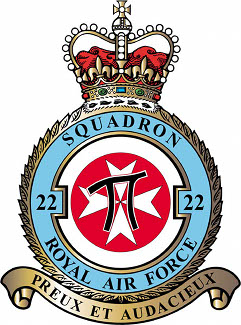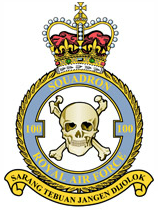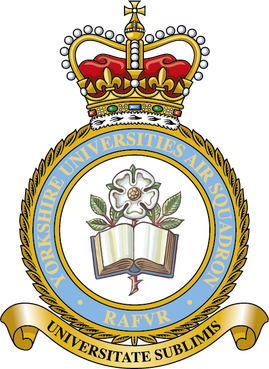
The Royal Air Force (RAF) is the United Kingdom's air and space force. It was formed towards the end of the First World War on 1 April 1918, becoming the first independent air force in the world, by regrouping the Royal Flying Corps (RFC) and the Royal Naval Air Service (RNAS). Following the Allied victory over the Central Powers in 1918, the RAF emerged as the largest air force in the world at the time. Since its formation, the RAF has taken a significant role in British military history. In particular, during the Second World War, the RAF established clear air superiority over Hermann Göring's Luftwaffe in the Battle of Britain, and led the allied strategic bombing effort.

Royal Air Force Leeming or more simply RAF Leeming is a Royal Air Force station located near Leeming, North Yorkshire, England. It was opened in 1940 and was jointly used by the RAF and the Royal Canadian Air Force (RCAF). Between 1950 and 1991, it operated mostly as a training base with Quick Reaction Force (QRF) Panavia Tornado F3 fighters based there in the latter stages of the Cold War and into the early 21st century. Since 2006, it has become the home of the deployable RAF communications cadre and the home of No. 135 Expeditionary Air Wing.

Royal Marines Barracks Chivenor is a British military base used primarily by 3 Commando Brigade. It is situated on the northern shore of the River Taw estuary, adjacent to the South West Coast Path, on the north coast of Devon, England. The nearest towns are Barnstaple and Braunton.

RAF Spadeadam is a Royal Air Force (RAF) station in Cumbria, England, close to the border with Northumberland. It is the home of the 9,000 acre (36 km2) electronic warfare (EW) tactics range, making it the largest RAF base in the United Kingdom. Its primary use is for EW training to the RAF and NATO allies. The site and course of Hadrian's Wall runs a few miles south of the range.

Royal Air Force Finningley or RAF Finningley was a Royal Flying Corps and Royal Air Force station at Finningley, in the Metropolitan Borough of Doncaster, South Yorkshire, England. The station straddled the historic county boundaries of both Nottinghamshire and the West Riding of Yorkshire.

Number 22 Squadron of the Royal Air Force is an operational testing and evaluation squadron for all the Joint Helicopter Command helicopter types including Chinook, Puma HC2, Merlin HC4, Apache and Wildcat AH1. Formerly the Rotary Wing Operational Evaluation and Training Unit, the highly experienced helicopter aircrew will also ensure frontline crews have Qualified Warfare Instructors to support them on operations worldwide. The squadron was reformed in May 2020 to serve as the Joint Helicopter Command Operational Evaluation Unit.

Number 100 Squadron is a former Royal Air Force squadron. It last operated the British Aerospace Hawk T1, providing 'aggressor' aircraft for air combat training from RAF Leeming in North Yorkshire, UK.

Forward air control is the provision of guidance to close air support (CAS) aircraft intended to ensure that their attack hits the intended target and does not injure friendly troops. This task is carried out by a forward air controller (FAC).

The Tactical Air Control Party, commonly abbreviated TACP, is a small team of military personnel who provide coordination between aircraft and ground forces when providing close air support.

Joint Terminal Attack Controller (JTAC) is the term used in the United States Armed Forces and some other military forces for a qualified service member who directs the action of military aircraft engaged in close air support and other offensive air operations from a forward position. The term that is used in most other countries, as well as previously in the U.S. and in the relevant NATO standard, is Forward Air Controller. The term became effective in the U.S. on September 3, 2003 with the publishing of Joint Publication (JP) 3-09.3 Close Air Support.

Royal Air Force Brawdy, or more simply RAF Brawdy, is a former Royal Air Force satellite station located 6.3 miles (10.1 km) east of St Davids, Pembrokeshire and 9.8 miles (15.8 km) south west of Fishguard, Pembrokeshire, Wales. It was operational between 1944 and 1992; it was used by the Royal Air Force and the Royal Navy (1946–1971), before the site was turned over to the British Army and renamed Cawdor Barracks.

Number 19 Squadron is a squadron of the Royal Air Force. It was the first squadron to operate the Supermarine Spitfire. It currently operates the UK's Control and Reporting Centre from RAF Boulmer. No. 19 Squadron delivers persistent surveillance of UK airspace, and Tactical Control of RAF and NATO aircraft, including the UK's contribution to NATO's Quick Reaction Alert mission.

Cawdor Barracks is a British Army installation located 6.3 miles (10.1 km) east of St Davids, Pembrokeshire and 9.8 miles (15.8 km) south west of Fishguard, Pembrokeshire, Wales.

Exercise Joint Warrior is a major biannual multi-national military exercise which takes place in the United Kingdom, predominately in north west Scotland. It is the successor of the Neptune Warrior exercises and Joint Maritime Course.
At the end of the Cold War in 1989, the Royal Air Force (RAF) structure was as follows:

The Yorkshire Universities Air Squadron is a Royal Air Force flying training unit that currently operates out of RAF Leeming in North Yorkshire, England. One of fourteen University Air Squadrons, the unit traditionally recruits students from universities across the Yorkshire and Humber region and provides bursaries for those who wish to pursue a career in the Royal Air Force.
This is the structure of the Royal Air Force, as of October 2020.
11 Squadron is a flying squadron of the Qatar Emiri Air Force (QEAF). The squadron most recently reformed in November 2021 as a joint QEAF/Royal Air Force squadron. It is currently based at RAF Leeming, North Yorkshire, in the United Kingdom and operates nine BAE Systems Hawk Mk.167s. The unit provides advanced and high-speed jet training for both QEAF and RAF pilots.
















